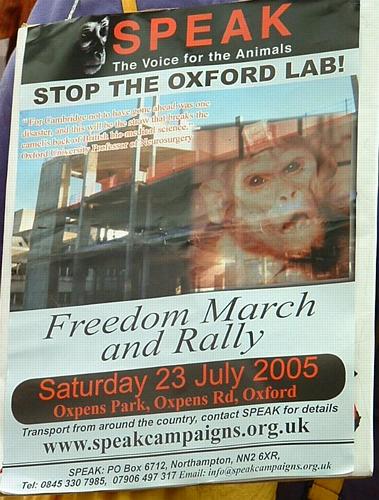
Poster for the Freedom march and rally, 23rd July 2005, Oxford
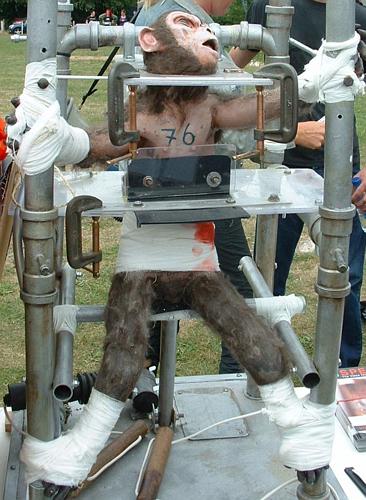
Artist's impression of a primate test subject
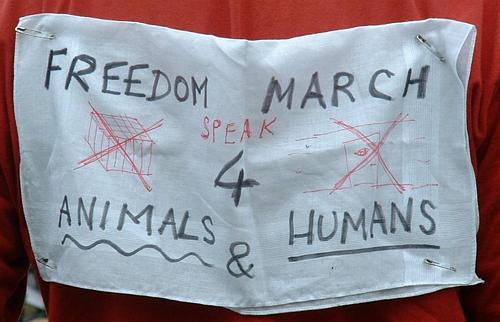
Freedom march for animals and humans

Abolition Liberation Freedom
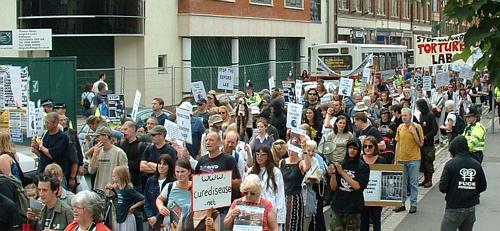
Marchers crossing the Thames
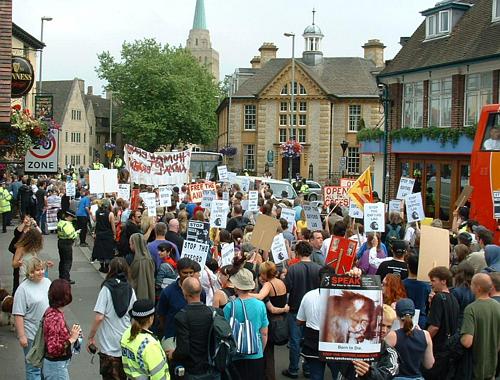
Marchers crossing the Thames
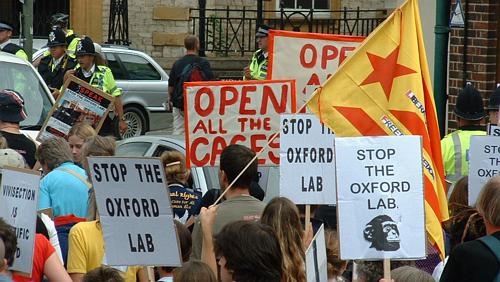
Some of the placards
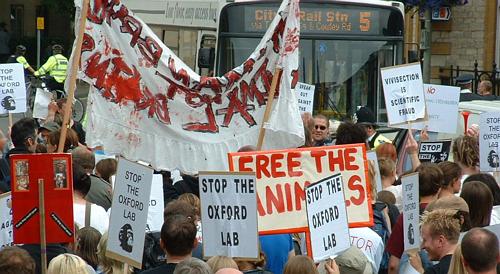
More placards and Zombie Activist banner
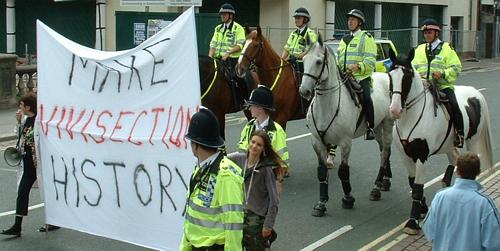
Make Vivisection History banner, marking the back of the march
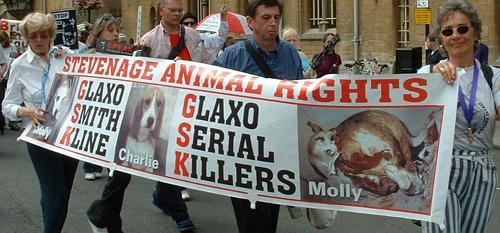
Stevenage Animal Rights
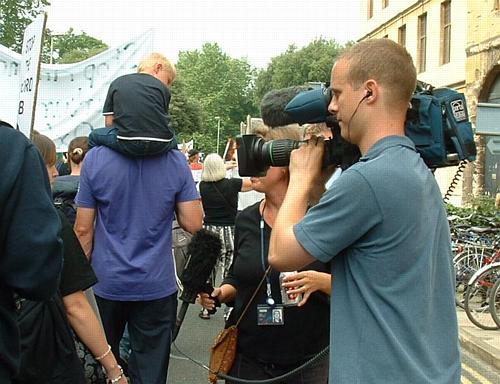
Central TV interview a marcher
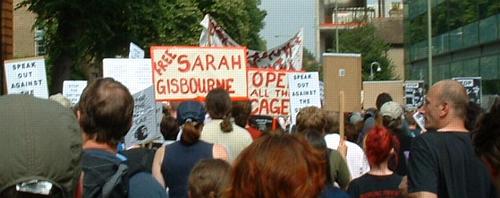
Just hold the camera over your head and press the button....
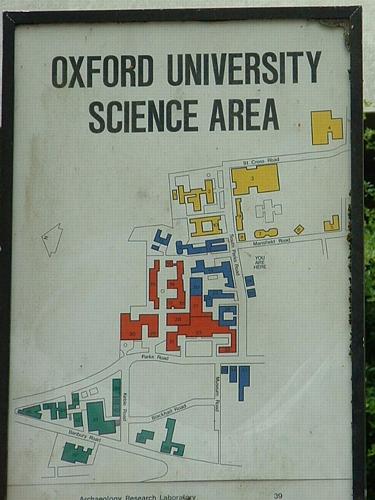
Oxford University Science Area
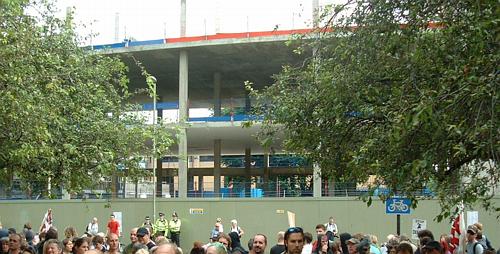
The lab that must never be built

Two-minute silence outside the lab
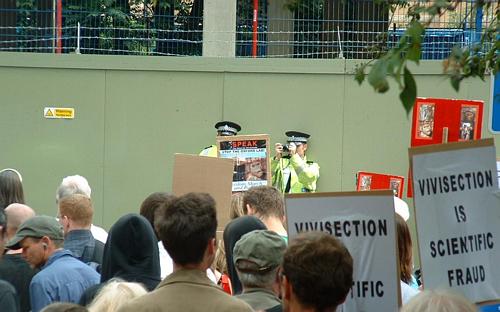
Police take pics of the two-minute silence
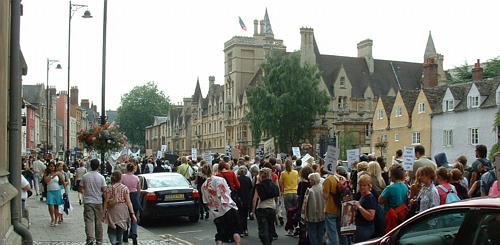
Marching in silence back through Oxford city centre
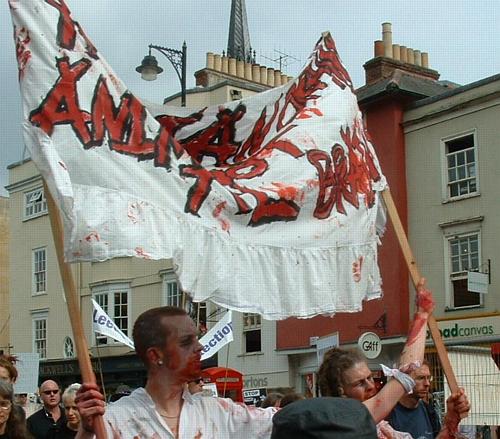
Zombie Activists
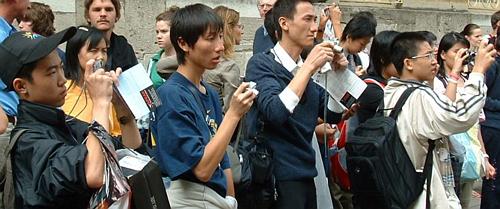
Onlookers with cameras
Police restrictions
Matt Roussell’s speech
Matt Fraser’s speech
Dr Jarrod Bailey’s speech
The march there
Bev and the two minute silence
Steve Best’s speech
The march back
Other reports
====== Police restrictions
Everyone entering the park was handed an A4 sheet by policemen in high-visibility jackets, setting out restrictions on public assemblies and processions under sections 12 and 14 of the public order act 1986. Although unnecessary in the humble opinion of this photojournalist, they were less over-the-top than restrictions imposed by the same police force on the peace march and rally at Brize Norton in April (see
 http://www.indymedia.org.uk/en/2005/04/309720 ).
http://www.indymedia.org.uk/en/2005/04/309720 ). Rather than five pages, this time there was a single sheet, with the section 12 and 14 orders printed on one side, and a route map of the march helpfully provided on the other side.
“… to avoid serious damage to property and to avoid serious disruption to the life of the community,” Assistant Chief Constable Alan M[illegible surname] of Thames Valley Police imposed conditions including …
… A specific route and timing for the procession from Oxpens park to the half-built lab and back, through the centre of Oxford …
… the procession to take up no more than half the carriageway …
… no stopping or slowing down without reasonable excuse or as directed by the police …
… no more than 8 persons handing out leaflets during the course of the procession, and not to form part of the procession itself …
… no vehicles in the procession …
… specific location and time (20 minutes) for the assembly outside the lab …
… no more than 1000 people to assemble (so what happens if 1001 people turn up – who do they arrest? How accurately can they count?) …
… and the usual warning that breaking the conditions or inciting anyone else to break them is an arrestable offence.
We don’t get that sort thing on the big Stop the War demos in London, but it seems to be quite a popular tactic amongst the police community in Oxfordshire
Suitably intimidated, I moved on into the field, had a “cheating ham” roll and a flapjack (100% vegan and very nice too), and browsed the literature on display from organisations including SPEAK and Europeans for Medical Progress. I also bought a vegan passport, which states in over fifty different languages that the bearer is a vegan, and explains what this means in terms of what they do and do not eat.
The public assembly was called to order and asked to gather around the stage, where the first three speakers were being lined up: Matt Roussell, Matt Fraser and Dr Jarrod Bailey. First, the compere (whose name I didn’t catch) said a few introductory words. “It’s going to be an education for all of us,” he said, “and hopefully an inspiration to everyone.”
===== Matt Rousell’s speech
Matt Roussell worked undercover in a primate vivisection laboratory in the USA (the Oregon Regional Primate Research Centre) for two years, and related some shocking tales of incompetence and cruelty. Matt’s job was officially to look after the welfare of the primates, but in reality it was more concerned with producing paperwork to prove to a yearly inspector that they’d been keeping paperwork.
He related how the terrible conditions endured by primates in the lab, for sometimes twenty or thirty years, caused abnormal behaviour such as pulling out their hair, circling and pacing, back-flipping, eating and drinking their own body wastes, abusing their young because they never learned how to bring them up, even going completely mad and causing serious physical damage to themselves. He said that each of these primates was as much of an individual as he or any of the audience, and to bring this home, he told us the personal stories of two of these individuals, one of which is summarised here.
Snicker was a capuchin monkey, one of twenty-eight elderly capuchins who had spent most of their lives as test subjects for psychotropic drugs. She had a history of bad reactions to the mind-altering substances, including biting her own fingertip off. She would incessantly lick at a single place on her skin until it cased a wound which started to bleed, and whenever they tried to treat or bandage this wound, she would start doing the same thing to another place on her skin.
One day he found her in her cage in a pool of blood, clearly suffering and dying. He took her to the resident vet to be put out of her misery, but the vet refused to do anything without permission from the head researcher, who could not be found for several hours. This is yet another example of animals being treated as property rather than as individuals in their own right, a theme which one of the later speakers picked up on.
“You don’t have to love animals to hate animal research”, he said. “It’s not an animal rights issue. We’re wasting money torturing animals, which should be used to help people.”
“Animal research is sloppy science,” he said, describing how understaffing meant he found himself drawing blood from the primates, having been trained by someone who had only been trained two weeks earlier, and how he’d been giving injections without any training, and doing it wrong for weeks before anyone pointed out his mistake. With blood being drawn from the wrong monkeys and the wrong ones being sent to surgeries by under-qualified overworked technicians in an assembly-line mentality, the data produced by such “research” cannot be reliable, regardless of your position on animal rights.
On a positive note, he was pleased to announce that Snicker’s fellow capuchin monkeys had finally been released from the laboratory in Oregon. But better than liberating animals from a vivisection lab, is preventing such a lab from ever being built, he said, to enthusiastic cheers from the audience.
===== Matt Fraser’s speech
Matt Fraser was introduced by the compere as an actor, although there was a subtle element of stand-up comedy mixed in with his message. He opened by suggesting that we should change our terminology – instead of saying things like “I’m a right pig in the kitchen”, we should say things like “I’m a bit of a human when it comes to food”. This joke probably doesn’t translate too well into plain text.
By now, most of the audience had probably noticed that Matt’s arms were considerably shorter than average. This, he explained, was a result of the infamous drug Thalidomide (
 http://en.wikipedia.org/wiki/Thalidomide ), which was sold in the 50s and 60s to pregnant women as a treatment for morning sickness, and caused thousands of dead and deformed babies. The company which invented, tested and marketed Thalidomide put it through the bare minimum of testing before marketing it, which they did heavily. Initially, it was only tested on male rats, then on female rats in the late stages of pregnancy, and was passed as safe for homo sapiens based on this flimsy evidence. Had they used modern in-vitro (literally, “within glass”, i.e. in a test tube or similar) testing methods with human cells, they would have discovered that it was a bad idea to give Thalidomide to pregnant women.
http://en.wikipedia.org/wiki/Thalidomide ), which was sold in the 50s and 60s to pregnant women as a treatment for morning sickness, and caused thousands of dead and deformed babies. The company which invented, tested and marketed Thalidomide put it through the bare minimum of testing before marketing it, which they did heavily. Initially, it was only tested on male rats, then on female rats in the late stages of pregnancy, and was passed as safe for homo sapiens based on this flimsy evidence. Had they used modern in-vitro (literally, “within glass”, i.e. in a test tube or similar) testing methods with human cells, they would have discovered that it was a bad idea to give Thalidomide to pregnant women. Matt went on to describe how when the first cases of Thalidomide side-effects were reported, instead of withdrawing the drug, the company bombarded doctors with marketing material, and generally tried to stop anyone finding out the truth.
“How come,” he asked, “if in a court of law you say ‘well I tested it on animals’, that’s OK? I don’t get that. It’s medically inefficient, so it should be logically inefficient, and therefore legally inefficient.”
“How come,” he went on, “is ‘animal rights’ a dirty phrase? When I was a nipper, ‘private enterprise’ was a dirty phrase”, and he thanked the fifty-year-olds for clapping.
He told how Central TV had interviewed him earlier, and he criticised their interview technique. They had asked him two questions – 1) Why are you here? 2) What do you think about violent animal liberation front people da-da da-da da-da…? He refused to answer the second question as that wasn’t why we were all there. Instead he told them what he thought about the half-built vivisection lab down the road.
Photojournalist’s note: The corporate media seem to be incapable of reporting an animal rights story without throwing in a vague reference to balaclava-wearing thugs firebombing someone’s home or stealing their dead granny’s body. These horror stories which the press feed us just don’t sit comfortably alongside my personal experience of the people I’ve met in several years of campaigning for animal welfare, who usually seem to be environmentally conscientious and hate any kind of violence, and for whom “direct action” probably means taking in an animal which has been rescued from an abusive home, or a day out with the hunt saboteurs for anyone who’s feeling brave.
“Animal testing is the least efficient method.” continued Matt. “It doesn’t work. If we had stem cell technology in the late fifties, Thalidomide could have been prevented.” He said that he has no objection to human tissues or bodies being used for medical research because he doesn’t believe that we are superior to other species.
“Even with his grossly polluted body, we would probably get better test results from testing on John Prescott than from any other animal.”
He commented that MI5 were probably amongst us, which he said was a shame, because “given what’s been going on in London the last couple of weeks, you’d think they’ve got something better to do”, which prompted an enthusiastic response from the audience.
In closing, he urged the audience to visit the stall hosted by Europeans for Medical Progress and read their literature, and take it to our “schools, colleges, canteens, green rooms, staff rooms, smoking cupboards et cetera, and let people know why we’re all here today.”
“Let’s make animal testing an embarrassing thing of the past, as embarrassing as asbestos, bear baiting, apartheid and witch-hunting.”
===== Dr Jarrod Bailey’s speech
Arguments about vivisection often end up revolving around the thorny issue of whether or not animals have rights. This is a highly emotive subject, and ultimately cannot be proved one way or the other, any more than one can prove or disprove the existence of [God | Allah | Jehovah | Blind Io | insert name of deity here] or their impact, if any, on our world. It’s a matter of personal belief which you can argue about until you’re blue in the face (or you can go and find someone slightly more receptive to persuade).
Dr Jarrod Bailey, Scientific Director of Europeans for Medical Progress (
 http://www.curedisease.net ), put the animal rights question aside, and focussed on the message that using species other than Homo sapiens as test subjects when trying to work out the effect of a particular substance on Homo sapiens is simply bad science, and produces unreliable data which kills Homo sapiens as well as other species.
http://www.curedisease.net ), put the animal rights question aside, and focussed on the message that using species other than Homo sapiens as test subjects when trying to work out the effect of a particular substance on Homo sapiens is simply bad science, and produces unreliable data which kills Homo sapiens as well as other species. “People simply aren’t aware”, he said, “that animal research has set back medical progress by years.”
“There is still a common misconception, that as people who are trying to stop animal experiments, we are the ones getting in the way of medical progress, and that we should answer to the people who are suffering from these diseases, who are relying on animal experiments to find the cures.”
He admitted to having held similar views himself many years ago, but he was presented with evidence showing that this view was wrong, and he gave some examples.
… studies showing that toxicity tests on animals matched the known results for the same substances in humans, in between one in three and one in twenty cases …
… animals being used as models for human diseases that those animals don’t even get …
… all progress on research into Alzheimer’s and Parkinson’s diseases has come from human-based studies, not animal experiments. An Alzheimer’s vaccine developed in mice and tested on chimps didn’t work in humans, and in fact killed people …
… adverse drug reactions are the fourth biggest killer in the western world, despite animal tests that “showed” that the drugs were safe …
“We have to ask, why does animal experimentation persist?” he asked. “Of course, the best think to do would be to ask the people who do it. But you will not get a truthful answer.”
He made some observations about the vested interests which keep vivisection going.
“It’s huge business, it’s big, big business, worth billions every year to the pharmaceutical industries that rely on animal experiments. It’s worth huge amounts of money to the companies that breed, sell and import the animals, and that make their cages and their bedding.”
“The careers of so many scientists are built on animal experiments.”
On a positive note, he said “Many scientists and doctors, many of great esteem, have been humble enough to criticise the fraud that is animal experimentation.” He quoted from one of then who had pointed out that we’ve been curing cancer in mice for years, but it hasn’t helped us cure it in humans.
Dr Bailey informed the audience of a survey carried out by Europeans for Medical Progress last year, which showed that 82% of GP’s agree that animal tests are misleading when applied to humans.
“The next time that someone tells you that animal experiments were involved in the development of every single drug that exists, and that if you take these drugs you’re a hypocrite, you can tell them, that animal experiments have hindered drug development, that they’re completely unnecessary, that relying on the information from them is dangerous, and that in no way is anybody that takes drugs a hypocrite. And the next time someone tells you that animal experiments have been central to medical advancement, ask them where their evidence is.”
The compere took to the stage again to say a few words before the march set off.
“I’m sick to death of being called an extremist” he said. “I’ve had enough of the press reports. Where were you when only a few short months ago, Oxford University were investigated for abusing a primate in one of their laboratories? Where was the condemnation of the violence, the suffering that that animal went through? Nowhere? Where was it from the University, the government, the drug industry? No, silence. Except when it comes to attacking us. And the reason they’re doing it to us is because they’re losing.”
===== The march there
The march left Oxpens Park and turned left along Oxpens Road, heading into the city centre, with placards and banners bearing messages such as “Vivisection is scientific fraud”. With a fine compliment of whistles, air horns, drums and other percussion instruments (no samba band sadly), and chants of “Stop the Oxford lab” and “There’s no excuse for animal abuse”, it was probably the loudest demo I’ve seen in several years. There was also a strong visual element, with many wearing white lab coats stained with fake (I hope) blood, and a small role-playing contingent in ripped bloodstained shirts, made up with pale faces and more blood, and subtly branded as Zombie (A)ctivists.
At one point, I spotted a police photographer fulfilling his role from the top of one of the omnipresent open-top tourist buses, and I nearly kicked myself for not thinking of that myself. The police with cameras (still and video) were a constant presence amongst what was not an excessive overall police presence. I reflected briefly on how much footage the police must have of me walking past with a placard, or of my inner clown waving and smiling for the camera, and what a vital tool that must be in preventing deluded fools from blowing themselves up on the underground.
Passing through the city centre, we reached the site of the half-built laboratory which was the focus of the day. It didn’t look much like a lab, more like a generic skeleton of a modern office building, although bearing a surreal resemblance to a multi-storey car park. It was surrounded by the sort of tall solid wooden fence which tends to surround building sites, and that in turn was surrounded by a thin line of police to make sure that the public assembly stayed in its allotted space.
As the marchers made themselves comfortable on the entrance steps of a closed administration building on the other side of the road and the grass in front of it, two more speakers were lining up.
===== Bev and the two-minute silence
After delivering some stirring rhetoric about the animal rights movement being stronger and smarter and more resolute than it ever has been before, the next speaker, who is only listed as “Bev” in my notes, asked us to face the skeleton of the half-built lab for a two-minute silence, while a wreath was laid in front of it.
As sirens from two megaphones marked the end of the silence, the assembled protesters cheered, banged drums and blew horns. There was a sudden disturbance on the far side of the assembly, next to the police line which stood between the protestors and the fence surrounding the lab, with some shouts of “fascist”, however I was not in a position to observe it from my prime speaker-snapping position. The compere quickly called the protestors’ attention back to the steps of the admin building, and introduced the final speaker, Steve Best, philosopher and author of a book called “Terrorists or Freedom Fighters”.
===== Steve Best’s speech
“I bring you a huge embrace, a message of solidarity from the United States, what I call the USSA (that’s SS as in Nazi). And despite what you may have read in the paper, I am not an animal rights fanatic, I am an animal rights fan. I did not come to the UK, to England, to break laws and to destroy property. I came to be part of history, and we’re making it right now.”
“We watch you from the United States, and we take inspiration from what is happening in the UK, because you people are the cutting edge of animal rights history.”
He spoke of the situation activists in the US face, of cops bashing down doors, stealing their computers and files, subpoenas to appear before eco-terrorism hearings. “We are reliving the nightmare of McCarthyism in the United States.”.
“It’s because we are as effective as we are today.”
According to the powers that be in the US, he informed us, the animal rights movement is the number 1 domestic threat, above neo-nazis, gun nuts, homophobes, anti-progressives, organised crime gangs with possible links to real terrorists, the real extremists. “They’ve put us in that place because corporations set the agenda, and we have attacked the corporations with a mighty hand.”
He had a message for the Home Office: “I come here in non-violence, not violence, in the name of peace.”
He had received a letter the previous year from the Home Office, telling him they “had a mind to exclude” him from the country.
“We are the effect of conflict in society,” he said, “not the cause. Wherever there is a disturbance in the animal world, there will be, there must be a disturbance in the human world.”
“There will be no peace until there is justice, and we will bring justice to this planet. We will heal this wound, and our relationship with the natural world. That is our ultimate destiny; our ultimate goal is to heal the wound.”
“I want to ask every police officer, with all due respect, attending this, hearing me right now. I want to ask you. Why are you here instead of in London? I think there are some sleeper cells about to awake, and yet you’re watching us! And yet you’re photographing us. And yet you’re harassing us.” The audience noisily expressed their agreement with this sentiment.
===== The march back
The compere delivered some more stirring words to round off the public assembly, and the protestors then left the vicinity of the lab, back the way they came through the city centre and to Oxpens Park. On joining Broad Street, they demonstrated the discipline and ability to act as one, by marching in silence as hundreds of onlookers gawped and took photos, and occasionally crossed the street through the march. With the exception of one embarrassed marcher who hadn’t turned his phone off, this silence was maintained for almost the whole length of the street, before the marchers resumed their previous noise levels almost simultaneously. The silence did not diminish the communication-to-general-public element though, as the march was positively bristling with messages and images on placards and banners carefully held in positions where they would be most visible to the onlookers.
On our return to Oxpens Park, the compere thanked all the speakers, and thanked the protesters on behalf of the thousands of animals which will not suffer in the never-to-be-finished vivisection lab down the road.
As the coach back to the North-West of England was announcing its imminent departure and the other protesters were dispersing, I spotted the man who had introduced all the speakers, and had spoken quite passionately himself, walking round the field to make sure no litter was left behind, which was a nice touch.
===== Other reports
The following Monday, I scanned some likely mainstream news web sites for mentions of this demonstration, and found only the following, in which a senior Oxford police officer got the headline by lashing out at the organisers for making him deploy “at least 40” officers to police the demo, at a time when “officers should be dealing with issues of national security”. Would he level the same criticism if he was required to deploy officers to, say, a football match, when “officers should be dealing with issues of national security”, I wonder?
 http://thisisoxfordshire.co.uk/oxfordshire/archive/2005/07/25/NEWS1ZM.html
http://thisisoxfordshire.co.uk/oxfordshire/archive/2005/07/25/NEWS1ZM.html The UK Indymedia animal liberation newswire turned up a brief early report, drawing on Dr Jarrod Bailey’s speech. I’ve copy/pasted this report below (thanks to the way in which Indymedia likes to promote the idea of copyleft
 http://en.wikipedia.org/wiki/Copyleft ).
http://en.wikipedia.org/wiki/Copyleft ).  http://www.indymedia.org.uk/en/2005/07/319291.html
http://www.indymedia.org.uk/en/2005/07/319291.html Researchers Speak Out Against Animal Tests
I witness | 23.07.2005 15:36 | Animal Liberation | Bio-technology | Health | Cambridge | Oxford
The scientific director of Europeans for Medical Progress today spoke strongly against the building of the proposed primate experimentation lab in Oxford. The lab's construction has so far been halted for just over a year by popular protest.
According to Dr Jarrod Bailey, scientific director of Europeans for Medical Progress, 82% of GPs believe that animal experiments produce medically misleading results. Europeans for Medical Progress is an independent organisation of scientists and medical professionals that has prepared a petition calling for an independent investigation into the scientific merits of animal-based medical research.
"As someone who has spent years looking for a scientific justification behind animal experimentation, I think 'fraud' is the right word," Dr Bailey announced. He stated that although animal research has been "involved" in every major medical advance (as the pharmaceutical industry claims), its involvement has been incidental at best - and often a serious setback to scientific advances.
"All progress on AIDS has been despite animal experiments, which have produced misleading results," he said. He also said that research into cancer, stroke, multiple sclerosis, parkinson's disease and other serious illnesses has been distracted and delayed by scientifically invalid and ultimately misleading results from research using animals to model human responses. Even the notoriously conservative US Food and Drug Administration describes animal experimentation as "using 20th century technology for 21st century problems".
Dr Bailey said that using animal experimentation causes deaths through the release of drugs incorrectly found to be safe in animal trials. Adverse drug reactions is the fourth largest single cause of death in the UK.

Comments
Display the following 3 comments